2. 四川赛思特科技有限责任公司, 成都 610041;
3. 中国地震局地质研究所地震动力学国家重点实验室, 北京 100029
2. Sichuan Seistech Corporation Ltd., Chengdu 610041, China;
3. State Key Laboratory of Earthquake Dynamics, Institute of Geology, China Earthquake Administration, Beijing 100029, China
据中国地震台网中心(CENC)测定,2017年8月8日21时19分46.4秒,在四川省阿坝州九寨沟县发生M7.0强烈地震(图 1a),震中位于33.22°N、103.83°E,震源深度20 km.美国地质调查局(USGS)、美国地震学研究联合会(IRIS)、德国地球科学研究中心(GFZ)等机构也给出了本次地震参数,震源深度9 km (表 1),小于CENC给出的深度.截止到2017年8月14日,九寨沟M7.0地震已造成25人遇难,525人受伤,6人失联,176492人受灾,73671间房屋不同程度受损,世界自然文化遗产九寨沟景区严重受损.基于现场考察和强震记录,中国地震局给出了本次M7.0地震的等震线分布,等震线呈近椭圆形,长轴走向NNW,极震区烈度达Ⅸ度,长约19 km,Ⅷ度区长约45 km.
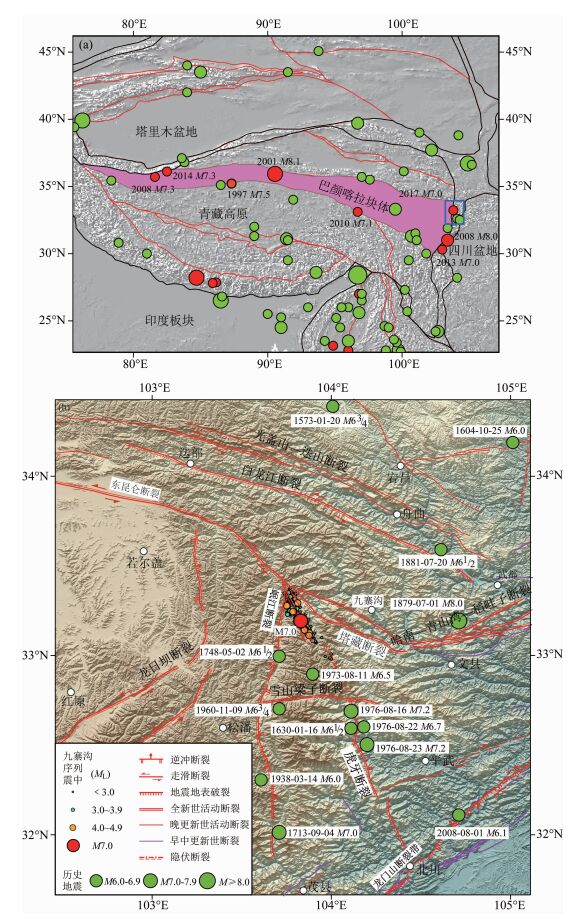
|
图 1 区域构造与历史地震震中分布 (a) 1900年以来7级以上地震分布,红色代表 1997年以来地震,蓝色方框标示图 1b范围; (b)九寨沟7.0级地震震中附近区域1573年以来M≥6.0级地震分布. Fig. 1 Regional tectonic settings and the epicenters of the historical earthquakes (a) Spatial distribution of M≥7.0 historical earthquakes since 1900, green and red dots mark the earthquakes occurred before and after 1997, respectively. (b) Spatial distribution of M≥6.0 historical earthquakes since 1573 in zoom area marked by a small blue rectangle in Fig. 1a. |
|
|
表 1 CENC与USGS等机构给定的九寨沟M7.0地震震源参数 Table 1 Source parameters of the M7.0 Jiuzhaigou earthquake from CENC, USGS, IRIS and GFZ |
九寨沟M7.0地震发生在南北地震带中北段、青藏高原东缘巴颜喀拉块体内部,邻近该块体北边界断裂带.自1997年以来,围绕巴颜喀拉块体边界断裂带发生了一系列7.0级以上大地震(图 1a),构成了中国大陆强震主体活动区(邓起东等,2010;M7专项工作组,2012),如,沿其南边界曾发生1997年玛尼M7.5和2010年玉树M7.1地震,沿北边界则发生了2001年昆仑山口西M8.1、2008和2014年于田2次M7.3地震,特别是在该块体的东边界龙门山断裂带上新近发生了2008年汶川M8.0和2013年芦山M7.0地震.本次九寨沟M7.0地震则发生在该块体的北边界东昆仑断裂带东端与东边界岷山构造带交汇区域(图 1b),震中位于M7专项工作组(2012)在川甘青交界划定的未来10年7级以上地震危险区内.
精确定位后的主震及其余震序列空间展布和震源机制解,对于震后快速确定发震构造、判定未来地震发展趋势及灾后恢复重建规划等均具有重要意义(Waldhauser and Ellsworth, 2000; Rubin, 2002;Hauksson et al., 2012;赵博等,2013;Xie et al., 2013, 2015;易桂喜等, 2015, 2016a, 2016b).九寨沟M7.0地震震中所处川、甘交界地区地震监测能力相对较弱,震中50 km半径范围内仅有1个测震台(JZG台),震中距约38 km(图 2).地震发生后,四川省地震局、甘肃省地震局在震区相继增设了6个流动台(图 2中红色三角形),第一个流动台(L6201) 于8月9日18时31分正式运行,极大地改善了余震监测与定位能力.
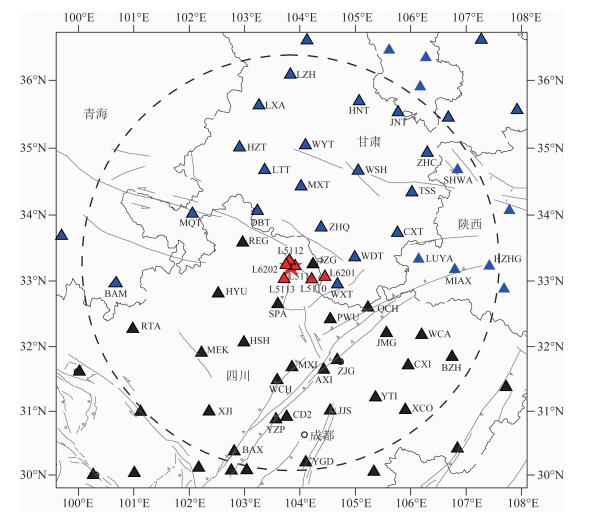
|
图 2 用于九寨沟M7.0地震序列重新定位和震源机制解计算的地震台站(▲)分布 红色三角形代表流动台,黑色虚线圆代表九寨沟地震震中距350 km范围. Fig. 2 Distribution of seismic stations (▲) for relocation and focal mechanism calculation of the M7.0 Jiuzhaigou earthquake sequence Red triangles mark portable seismic stations. Black dashed circle indicates the range within epicentral distance of 350 km. |
本文利用截止至2017年8月14日的地震资料,采用Long等(2015)所发展的多阶段定位方法(multi-step locating method),对九寨沟M7.0地震及余震震中进行重新定位.同时,选取适用于稀疏台站分布的Cut and Paste(简称CAP)波形反演方法(Zhao and Helmberger, 1994;Zhu and Helmberger, 1996),求解九寨沟M7.0主震和ML4.0级以上余震的震源机制解与震源矩心深度,进而初步分析九寨沟M7.0地震的发震构造.本文结果可为进一步研究区域构造应力场分布特征、强震发震机理以及建立区域地球动力学模型提供基础资料和参考依据.
2 区域地质构造背景2017年8月8日九寨沟M7.0地震发生在青藏高原东缘巴颜喀拉块体东北部东昆仑断裂带东端与岷山构造带交汇区域(见图 1),震中附近发育的主要活动断裂有东昆仑断裂带及其东端分支塔藏断裂、岷江断裂带和虎牙断裂带(图 1b).
左旋走滑的东昆仑断裂带为巴颜喀拉块体的北边界,走向总体呈NWW—近EW,全长约1800 km(闻学泽等,2011),西起青海与新疆交界的鲸鱼湖西、经库赛湖、西大滩、托索湖、玛曲,穿过若尔盖盆地北缘,延伸至岷山北麓一带,自西向东大致可分为以下7个段落:鲸鱼湖段、库赛湖段、东西大滩段、阿拉克湖段、托索湖段、玛沁—玛曲段和塔藏段(刘光勋,1996;青海省地震局和中国地震局地壳应力研究所,1999;徐锡伟等,2002;江娃利和谢新生,2006;Kirby et al., 2007).邻近九寨沟M7.0地震震中的东昆仑断裂东段西起于若尔盖盆地北东,向SEE方向延伸至岷山以北一带,总体呈反“S”型,具有明显的晚第四纪新活动性,尾端发散呈多支次级断裂,构成马尾状或扫帚状构造样式(Cunningham and Mann, 2007;李陈侠等,2011).东昆仑断裂的水平滑动速率存在向东递减的特征,西段全新世左旋滑动速率达12±3 mm·a-1(刘光勋,1996;青海省地震局和中国地震局地壳应力研究所,1999;Van der Woerd et al., 2000),至东端近NW向的塔藏断裂,水平滑动速率仅1.0~3.0 mm·a-1(Kirby et al., 2007;李陈侠等,2011;张军龙等,2012).
位于东昆仑断裂带南侧的岷山构造带主要由近NS向岷江断裂带、NNW向虎牙断裂带和近EW向雪山梁子断裂带构成(图 1b),岷江与虎牙断裂带分别为岷山构造带的西边界与东边界,均为全新世活动断裂,控制了岷山隆起第四纪以来的地貌演化(赵小麟等,1994;周荣军等,2000;Zhang et al., 2006).逆冲兼走滑的岷江断裂带北起弓嘎岭以北,南至茂县以北,全长约170 km,走向近NS,断面西倾,倾角40°~70°,晚第四纪以来的平均垂直滑动速率为0.37~0.53 mm·a-1.水平位错量与垂直位错量大致相当(周荣军等,2006).虎牙断裂带主体位于岷山隆起东缘,全长约60 km,走向NNW,断面西倾(赵小麟等,1994;周荣军等,2000;张岳桥等,2012),第四纪以来的平均垂直滑动速率约0.5 mm·a-1,晚第四纪以来的水平滑动速率约1.4 mm·a-1(周荣军等,2006).岷山构造带尽管规模不大,但强震频发,最近300年相继发生了1713年叠溪7.0、1748年漳腊北


东昆仑断裂带向SEE的水平走滑及其应变除部分被岷江和虎牙断裂带吸收外,还有相当一部分滑移量转变为岷山—龙门山的构造隆起和地壳缩短(陈社发等,1994;张军龙等,2012),从而控制着区域强震的孕育发生以及复杂的构造变形特征.
3 九寨沟M7.0地震及余震序列重新定位基于四川区域地震台网提供的震相报告,我们采用Long等(2015)的多阶段定位方法(multi-step locating method),对本次九寨沟地震序列中具有4个以上台站记录的地震进行重新定位.该方法的定位过程包括:(1) 基于给定的初始速度模型,利用HYPOINVERSE2000(Klein, 1989)对序列进行初定;(2) 挑选其中具有6个以上台站记录、且方位角间隙小于150°的事件的观测报告,采用VELEST(Kissling, 1988;Kissling et al., 1994, 1995),反演九寨沟地区的最小一维速度模型和台站校正;(3) 将反演得到的速度模型和台站校正代入HYPOINVERSE2000进行重新定位;(4) 采用10 km的搜索半径,对校正后的震源位置进行双差定位(Waldhauser and Ellsworth, 2000).
自2017年8月8日九寨沟M7.0地震至8月14日,四川台网共记录0级以上余震3735次,以ML2.0级以下微震为主,M4.0以上余震仅3次,最大余震为8月9日10时17分M4.8地震.序列中具有4个以上台站记录的地震仅1647个,我们对其中记录台站方位角空隙小于180°的地震,选取震中距150 km以内台站的震相资料参与重新定位计算.同时,为了获得更合理的九寨沟地区一维速度模型,在重新定位过程中,我们还加入了本次地震震中附近自2000年以来满足条件的历史地震参与VELEST反演.参与定位所用的台站包括四川、甘肃、青海、陕西等区域台网布设在本次地震周边150 km范围内的固定台和震后增设的6个流动台(见图 2).
以赵珠和张润生(1987)的四川西部分区速度模型为初始模型,本文利用VELEST方法,经过60次反演,得到了九寨沟地区地壳平均P波一维速度模型(图 3).由图 3可见,九寨沟地区中、上地壳均存在厚度不等的低速层,但P波速度(VP)总体随深度递增.考虑到低速层均不太厚且速度变化不显著,在射线追踪时对理论走时的计算影响有限,因此,我们将其简化成递增模型(表 2,VP/VS取1.73),用于定位和震源机制解计算.
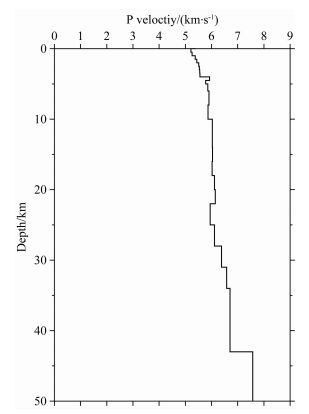
|
图 3 VELEST反演获得的九寨沟地区平均P波一维速度模型 Fig. 3 1-D P-wave velocity model of the Jiuzhaigou region from VELEST |
|
|
表 2 九寨沟地区一维速度模型 Table 2 1-D velocity model of the Jiuzhaigou region |
利用多阶段定位方法,我们最终获得了九寨沟序列957个ML≥0.1级地震的重新定位结果,相对定位误差为:水平EW向771 m、NS向802 m,垂直向1.3 km.M7.0主震重定位后的震源参数为:发震时刻2017-08-08 21:19:47.1,震中位置103.8167°E、33.1954°N,震源深度16.9 km;8月9日M4.8最大余震重定位震源参数为:发震时刻2017-08-09 10:17:03.1,震中位置103.8383°E、33.1516°N,震源深度18.7 km.由于主震及包括最大余震在内的半数ML4级以上余震发生在流动台开始工作之前,均缺乏近台约束,震源深度绝对误差可能远大于相对误差,因此,我们仅利用其相对准确的震中位置分析发震构造的平面展布.
重新定位后的九寨沟地震序列震中分布图(图 4)显示,余震密集区总体沿NW-SE向呈窄带展布,长轴走向与等震线基本一致,长度约38 km,小于Ⅷ度区长轴(45 km).8月9日M4.8级最大余震发生在主震南侧附近,主震几乎位于整个序列的中部,将余震区分为南、北两段,南段余震分布较窄,宽约6 km,北段余震分布相对弥散,宽约8 km,且余震区北段长轴走向有向北偏转的迹象.
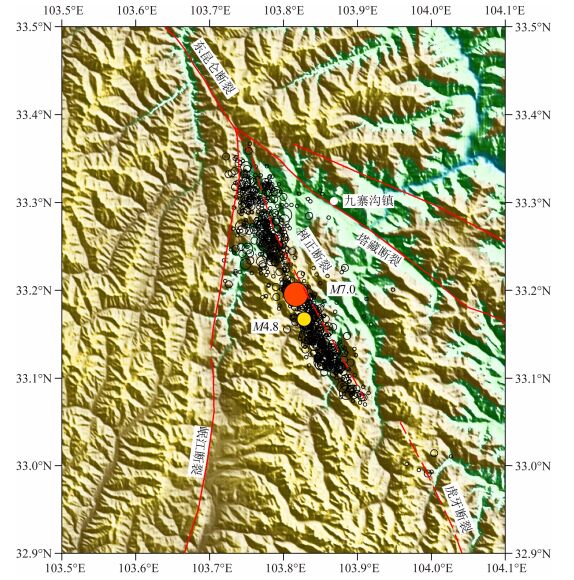
|
图 4 九寨沟M7.0地震及其余震重新定位震中分布(资料时段:2017-08-08—08-14) 黑色空心圆为重新定位的余震震中,红色圆为M7.0主震,黄色圆为M4.8最大余震. Fig. 4 Relocated epicenters of the Jiuzhaigou M7.0 earthquake and its aftershocks by August 14, 2017 The black hollow circles are relocated epicenters of aftershocks by 14 August 2017. The red and yellow circles mark the M7.0 mainshock and the M4.8 aftershock, respectively. |
考虑到本次地震发生在测震台站稀疏且结构与构造研究均相对薄弱的区域,我们选用了近年来广泛使用的CAP波形反演方法(Zhao and Helmberger, 1994;Zhu and Helmberger, 1996),获取九寨沟M7.0主震与ML≥4.0余震的震源机制解.该方法将地震波形记录分为体波Pnl与面波两部分,分别对Pnl波、面波进行带通滤波,计算理论波形与观测波形之间的误差函数,然后利用网格搜索,获取给定参数空间中误差函数达到最小的最佳解.CAP方法的主要优点是计算所需台站少、反演结果对速度模型依赖性较小(Tan et al., 2006;郑勇等,2009;龙锋等,2010;Zheng et al., 2010, 2012;易桂喜等, 2012, 2016a, 2016b),可保证震源机制解的稳定性与可靠性;此外,该方法在波形反演过程中采用了深度震相以及体波与面波的相对强度进行深度约束(罗艳等, 2015),可获得相对准确的震源深度,基于区域台网波形资料反演获得的震源深度误差在1~2 km内(郑勇等,2009).
考虑到震中附近台站记录的主震波形限幅,我们仅选取震中距150~350 km范围内的固定台站宽频带地震仪记录的高信噪比波形资料,反演九寨沟M7.0地震的震源机制解;而采用震中距300 km以内的固定台站高信噪比波形记录计算ML≥4.0余震的震源机制解.计算所用速度模型为本文获得的九寨沟地区一维速度模型(表 2),
计算中,对于主震,震源函数持续时间设置为8 s,体波与面波截取波形窗长分别为40 s和80 s,相应的带通滤波频带宽度为0.01~0.1 Hz和0.01~0.08 Hz;对于余震,持续时间设置为1 s,体波与面波截取波形窗长分别为30 s和60 s,相应的带通滤波频带宽度为0.05~0.2 Hz和0.05~0.1 Hz;断层面参数走向、倾角、滑动角搜索步长5°,深度步长1 km.图 5展示了M7.0主震反演误差随深度的变化,误差最小的最佳拟合深度为5 km.图 6给出了最佳拟合深度处部分台站理论波形和实际波形拟合图,可以看出,参与拟合的波形各分量拟合相关系数大部分高于80%,显示理论波形与实际波形具有较好的拟合关系.
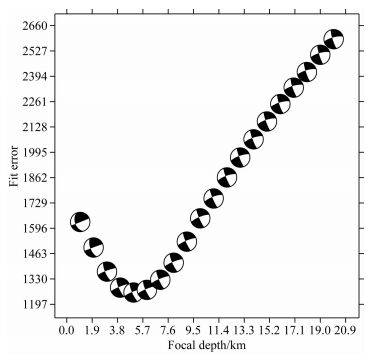
|
图 5 2017年8月8日九寨沟M7.0地震震源机制解反演残差随深度分布 Fig. 5 Variation of fitting error with depth during the focal mechanism inversion for the M7.0 Jiuzhaigou earthquake >on 8 August 2017 |
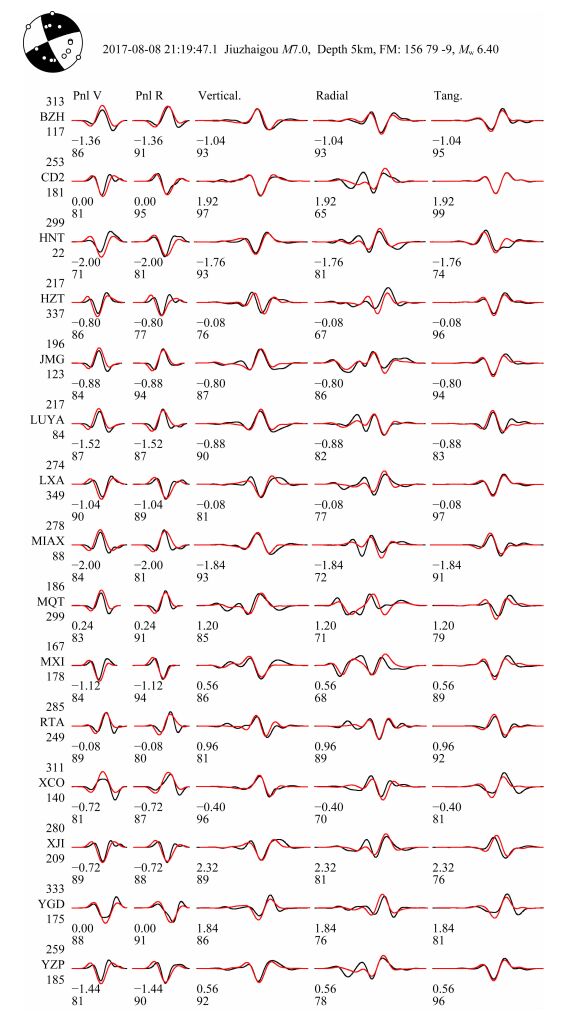
|
图 6 2017年8月8日九寨沟M7.0地震震源机制和理论波形与观测波形拟合图 红线表示理论地震图, 黑线为观测地震图, 波形左侧台站名上方的数字为震中距(单位:km),下部数字为方位角(单位:°);波形下方的两行数字分别表示理论地震图相对观测地震图的移动时间(单位:s)及二者的相关系数(用百分比表示). Fig. 6 Focal mechanism solution and comparison between observed and synthetic waveforms of the M7.0 Jiuzhaigou earthquake on 8 August 2017 The red and black lines are the synthetic and observed waveforms, respectively. The station names are given on the left, and the numbers above and below the names are epicentral distance (in km) and azimuth (in degree). Numbers below the traces are the time shifts (in second) of the synthetics relative to the observations and the corresponding cross-correlation coefficients (in percentage). |
CAP反演获得的九寨沟M7.0主震与13次ML≥4.0余震的震源机制解见表 3,表中仅列出了与余震震中分布NW-SE向长轴走向基本一致的节面信息.其中,M7.0主震震源矩心深度5 km,矩震级MW6.4,震源机制解节面Ⅰ走向156°、倾角79°、滑动角-9°;节面Ⅱ走向248°、倾角81°、滑动角-169°;P轴仰角14°,方位112°;T轴仰角2°,方位22°;P、T轴仰角均接近水平.主震震源机制解节面Ⅰ走向和倾角与USGS以及美国Harvard大学(HRV)给出的结果一致(表 3),但震源矩心深度存在较大差异.由宽频带波形资料反演获得的震源矩心深度有别于利用震相报告确定的初始破裂深度,反映的是地震矩张量密度分布的矩心深度(吴忠良和牟其铎,1994),高原等(1997)的研究表明,因使用资料的波长不同,对矩心深度的分辨率不同,本文利用区域台网波形资料反演获得的震源矩心深度分辨率高于USGS基于长周期体波资料和Harvard基于地幔波给出的矩心深度.
|
|
表 3 2017年8月8日九寨沟M7.0地震与ML≥4.0余震震源机制解 Table 3 Focal mechanism solutions of the 8 August 2017 Jiuzhaigou M7.0 event and its ML≥4.0 aftershocks |
13次ML≥4.0余震中,除8月10日3时2分发生的ML4.1地震震源矩心深度(3 km)浅于主震外,其余12次余震的震源位于6~12 km深度(表 3),均处于主震下部.为了确认本次M7.0主震的震源深度,我们在所有计算参数设置完全相同的情况下,采用本文的九寨沟一维速度模型(表 2)与易桂喜等(2016a)的龙门山断裂带南段一维速度模型,利用CAP方法分别反演了2013年芦山M7.0与九寨沟M7.0地震的震源深度,计算结果显示,基于九寨沟一维速度模型获得的2013年芦山M7.0地震震源矩心深度为14 km,与此前研究结果一致(吕坚等,2013;易桂喜等,2016a),反映震源相对较深,而基于龙门山断裂带南段一维速度模型获得的九寨沟M7.0地震矩心深度仍仅5 km,震源较浅.上述计算结果也说明CAP方法对速度模型不敏感,因而保证了计算结果的稳定性.
此外,为了更直观分析九寨沟M7.0地震发震构造的运动学特征与震源区构造变形特征,我们引入Amelung和King(1997)的应变花与Vallage等(2014)的面应变(Areal strain)As,基于震源机制解,分别计算了主震和13次余震整体的应变花,以及主震和13次余震的面应变As值,As值计算结果见表 3最后1列.
5 九寨沟M7.0地震发震构造分析从图 4可以看出,重新定位后的九寨沟M7.0主震及余震序列发生在东昆仑断裂带东端NW向塔藏断裂与近NS向岷江断裂带所夹持的区域,余震未扩展至东南侧早期地质调查划定的NNW向虎牙断裂带.根据断层空间展布和断层性质,可以排除塔藏、岷江断裂作为本次九寨沟M7.0地震发震构造的可能性,但无法完全排除是否为虎牙断裂向北西方向延伸的隐伏构造.
我们利用Vallage等(2014)发展的面应变As值,分析九寨沟主震及其余震的震源机制类型与发震断层运动学特征,分类标准如下:-1 ≤As<-0.7,正断型;-0.7≤As<-0.3,正断兼走滑型;-0.3≤As<0.3,走滑型;0.3≤As<0.7,逆冲兼走滑型;0.7≤As ≤1,逆冲型(易桂喜等,2016a).九寨沟M7.0主震As值近似于0(表 3),为纯走滑型(见图 5—7).13次余震中,8月9日8时29分发生在余震区北段东侧的ML4.4地震(表 3中No.4)As值接近于1,为纯逆冲型;8月9日9时22分发生在主震南侧紧邻最大余震的ML4.2地震(表 3中No.5)As值介于0.3~0.7之间,为逆冲兼走滑型;其余11次As值在-0.3~0.3之间,均为走滑型,且多数As值在0左右(表 3),为纯走滑型,与M7.0主震震源机制类型一致(图 7),表明主发震断层以走滑运动为特征.我们还给出了主震和13次余震的节面参数统计玫瑰花图(图 8),图像显示,节面走向(strike)集中在SE和SW两个优势方向,滑动角(rake)主要集中在0°和180°附近,呈典型的走滑运动特征.与余震带长轴方向一致的节面走向均值152.3°,倾角(dip)均值70.2°,表明发震断层走向SE,高倾角,断层面接近直立.
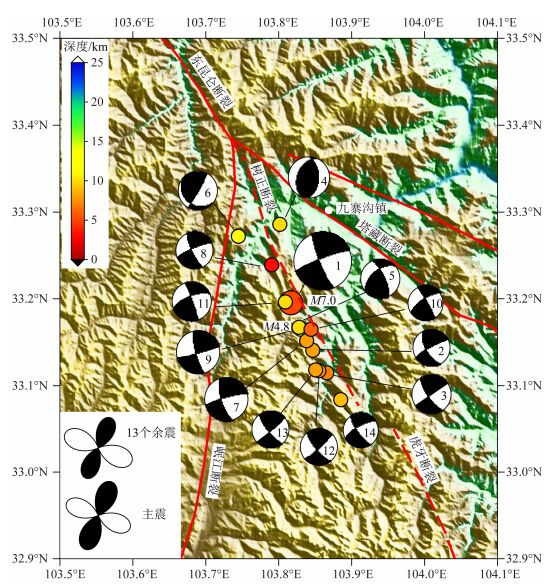
|
图 7 九寨沟M7.0地震及ML≥4.0余震震源机制解 震源机制球上的数字与表 3中的地震编号一致.左下角分别给出了主震和13次余震整体的应变花. Fig. 7 Focal mechanisms of the M7.0 Jiuzhaigou earthquake and its ML≥4.0 aftershocks The number on each beachball is the same as the first column in Table 3. Strain rosettes of the M7.0 mainshock and the entire 13 ML≥4.0 aftershocks are shown on the left corner in Fig. 7. |
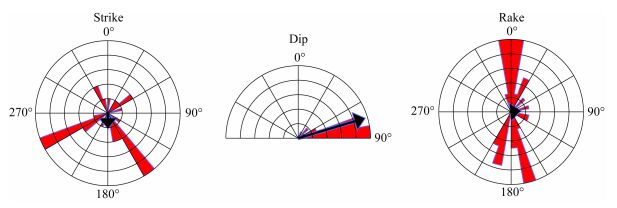
|
图 8 九寨沟地震序列节面走向(strike)、倾角(dip)、滑动角(rake)玫瑰花图 Fig. 8 Rose maps of the strike, dip, rake of nodal planes of the Jiuzhaigou earthquake sequence |
根据重定位后的九寨沟M7.0地震余震序列震中密集区长轴呈NW-SE向窄带展布(图 4)、主震与多数ML≥4.0余震的震源机制解为走滑型(表 3,图 7、图 8)以及等震线长轴呈NNW向展布的特征,结合震中附近区域的构造分布,推测本次九寨沟M7.0地震的发震构造为位于塔藏断裂与岷江断裂之间的一条NW-SE向无名断裂,该断裂此前无相关研究文献,震后被正式命名为树正断裂.与树正断裂走向一致的SE向节面为同震破裂面,因此,九寨沟M7.0地震为左旋走滑型地震. M7.0主震与余震震源机制解揭示,树正断裂呈左旋走滑,走向SE(约152°),倾向SW,倾角高陡,约70°.同时,基于断层性质和所处地理位置,推测树正断裂可能与塔藏断裂一样,同属于左旋走滑的东昆仑断裂东端扫帚状发散的分支断裂,或向南东方向与虎牙断裂构成统一断裂系(图 4、图 7).
图 9展示了P、T轴方位(az)和仰角(pl)玫瑰花图.P轴仰角均值约15°,优势方位单一,均值约106°,呈SEE向(图 9a);T轴仰角均值20°,优势方位NNE-SSW(图 9b).P、T轴均呈近水平,在这样的构造应力作用下,有利于NW-SE向断裂发生左旋走滑运动.本文获得的P轴优势方向与常利军等(2008)利用远震SKS偏振分析获得的震源附近区域SEE向剪切波快波方向一致.前人研究显示,本次地震震源区北部青甘地区现代构造应力场主压应力呈NE向(许忠淮等,1987),震源区附近呈EW-SEE向,至龙门山断裂带附近呈NW向,P轴方位自北向南顺时针旋转(王晓山等,2015),与利用GPS观测到的震源附近区域主压应变方向顺时针旋转(Shen et al., 2005;Gan et al., 2007;武艳强等,2011;陈长云等,2013; Wu et al., 2015; Yi et al., 2016)相吻合.上述特征可能揭示了相对软弱的青藏高原物质在印度板块的持续北向推挤作用下东向挤出(Tapponnier et al., 1982),在东北部和东南部分别受到刚性的鄂尔多斯块体和四川盆地的阻挡(Shen et al., 2015),物质的运移方向发生转折而呈现旋转特征,并在转折区域不断积累应变能,当达到介质强度极限时发生破裂引发强震.因此,九寨沟M7.0地震是青藏高原东缘地壳物质东向挤压导致东边界长期构造应变能积累的产物.

|
图 9 九寨沟地震序列P轴和T轴方位角(az)和仰角(pl)玫瑰花图 Fig. 9 Rose maps of the azimuth (az) and plunge (pl) of P-axis and T-axis of the Jiuzhaigou earthquake sequence |
九寨沟地震震源区处于青藏高原与鄂尔多斯地块过渡带(Shen et al., 2015),该过渡带也属于地壳岩石圈变形相对剧烈的区域.为了分析震源区构造变形模式,我们在图 7的左下角给出了本次九寨沟M7.0主震和13次ML≥4.0级余震整体的应变花.应变花是区域构造应变模式的图像体现(Amelung and King, 1997),被认为是进行应变模式定量比较的有力工具(Vallage et al., 2014),其黑瓣长轴走向代表拉张方向,白瓣长轴走向代表挤压方向.由图 7可以看出,九寨沟M7.0主震与13次余震整体的应变花形态(包括方位和形状)一致,反映同震和震后震源区构造变形特征一致,均呈NWW-SEE向挤压和NNE-SSW向拉张,且白瓣和黑瓣基本等长,表明挤压和拉张近似等量.
CAP波形反演结果显示,九寨沟M7.0主震震源矩心深度仅5 km,表明本次主震发生在上地壳浅部,但野外现场调查并未发现明显的地表破裂带,这一现象与2003年12月26日发生在伊朗东南部的巴姆(Bam)MW6.5级走滑型地震极为相似,Fialko等(2005)基于InSAR资料的研究揭示巴姆MW6.5地震的矩释放主要发生在上地壳浅部4~5 km深度,且同样未观测到明显的地表破裂(Talebian et al., 2004).强震与大震通常发生在高速体内(Kato et al., 2010; Zhang et al., 2010),郑勇等(2013)获得的精细S波速度结构表明,九寨沟7.0级地震震源区仅在上地壳浅部5 km左右为高速区,而在10 km及更大深度呈现低速异常,与徐小明等(2015)研究揭示的九寨沟地震震源区在10~25 km深度上S波呈低速分布特征一致,上述速度结构特征支持本次九寨沟M7.0主震发生在上地壳浅部(深度小于10 km)的结论.
6 认识与结论本文利用截止至2017年8月14日的地震资料,采用多阶段定位方法,对2017年8月8日发生在青藏高原东缘巴颜喀拉块体北边界附近的四川九寨沟M7.0主震及其余震序列进行了重新定位,同时,利用CAP波形反演方法,获得了M7.0主震和13次ML≥4.0级余震的震源机制解,初步分析了本次地震的发震构造.获得的主要认识与结论有:
(1) 九寨沟M7.0主震的矩震级MW6.4,震源矩心深度5 km,表明该地震发生在上地壳浅部,与2003年伊朗巴姆(Bam)MW6.5地震具有极为相似的特征.主震震源机制解节面Ⅰ走向156°、倾角79°、滑动角-9°;节面Ⅱ走向248°、倾角81°、滑动角-169°;P轴仰角14°,方位112°;T轴仰角2°,方位22°;P、T轴均近水平.13次ML≥4.0级余震以走滑型为主,其中12次余震的震源矩心深度在6~12 km范围内,位于主震下部,仅1次例外.
(2) 重新定位后的余震呈NW-SE向窄带展布于岷江断裂与塔藏断裂所围限的区域.余震区长轴长约38 km,M7.0主震处于余震带中部,余震带南段地震分布较集中,宽约6 km, 北段余震分布相对弥散,宽约8 km.
(3) 基于重定位后的余震震中分布、主震及余震震源机制解、震源附近区域构造展布等,推测本次九寨沟M7.0地震的发震构造为位于岷江断裂与塔藏断裂之间呈NW-SE向的树正断裂,与该断裂走向一致的节面(走向156°的节面)为同震破裂面,因此,九寨沟M7.0地震为发生在上地壳浅部的左旋走滑型地震.根据序列震源机制解SE向节面参数,树正断裂呈左旋走滑,走向SE(约152°),倾向SW,倾角约70°,该断裂可能属于东昆仑断裂带东端的分支断裂之一,或与东南侧的虎牙断裂构成统一断裂系.
截止至目前(2017年08月24日),九寨沟M7.0地震后发生的M≥4.0余震仅3次,即8月9日M4.8、8月10日M4.3和M4.1,与同类型M7.0地震相比,余震强度总体偏低,余震区是否还可能发生破坏性地震?九寨沟M7.0地震发生在东昆仑断裂带东端的一个分支,震中位于2008年汶川M8.0地震产生的应力增强区内(Toda et al., 2008),汶川地震可能加速了本次地震的发生,那么,本次地震是否会触发相邻分支断裂甚至主断裂东昆仑断裂在破裂空段发生强震?此外,本次九寨沟M7.0地震发生在上地壳浅部而无地表破裂,控制本次破裂扩展的主要因素是什么?上述问题均有待深入研究.
致谢感谢九寨沟地震现场工作队及四川省地震局监测中心各位同仁的辛勤付出.应变花计算程序由法国巴黎地球物理研究所Yann Klinger教授和Amaury Vallage博士提供.CAP程序由美国圣路易斯大学的朱露培教授提供.部分图件采用GMT软件绘制.两位审稿专家提出了宝贵的修改建议.
Amelung F, King G.
1997. Large-scale tectonic deformation inferred from small earthquakes. Nature, 386(6626): 702-705.
DOI:10.1038/386702a0 |
|
Chang L J, Wang C Y, Ding Z F.
2008. Seismic anisotropy of upper mantle in the Sichuan and adjacent regions. Science in China (Ser. D)-Earth Sciences, 51(12): 1683-1693.
DOI:10.1007/s11430-008-0147-8 |
|
Chen C Y, Ren J W, Meng G J, et al.
2013. Division, deformation and tectonic implication of active blocks in the eastern segment of Bayan Har block. Chinese J. Geophys, 56(12): 4125-4141.
DOI:10.6038/cjg20131217 |
|
Cunningham W D, Mann P.
2007. Tectonics of strike-slip restraining and releasing bends. Geol. Soc. London Spec. Publ, 290: 1-12.
DOI:10.1144/SP290.1 |
|
Deng Q D, Gao X, Chen G H, et al.
2010. Recent tectonic activity of Bayankala fault-block and the Kunlun-wenchuan earthquake series of the Tibetan Plateau. Earth Science Frontiers, 17(5): 163-178.
|
|
Department of Earthquake Disaster Prevention, China Earthquake Administration. 1995.
The Catalogue of Chinese Historical Strong Earthquakes. Beijing: Seismological Press.
|
|
Department of Earthquake Disaster Prevention, China Earthquake Administration. 1999.
The Catalogue of Chinese Modern Earthquakes. Beijing: Seismological Press.
|
|
Fialko Y, Sandwell D, Simons M, et al.
2005. Three-dimensional deformation caused by the Bam, Iran, earthquake and the origin of shallow slip deficit. Nature, 435(7040): 295-299.
DOI:10.1038/nature03425 |
|
Gan W J, Zhang P Z, Shen Z K, et al.
2007. Present-day crustal motion within the Tibetan Plateau inferred from GPS measurements. J. Geophys. Res, 112.
DOI:10.1029/2005JB004120 |
|
Gao Y, Zhou H L, Zheng S H, et al.
1997. Preliminary discussion on implication of determination on source depth of earthquake. Earthquake Research in China, 13(4): 321-329.
|
|
Hauksson E, Yang W, Shearer P M.
2012. Waveform relocated earthquake catalog for southern California (1981 to June 2011). Bull. Seismol. Soc. Amer, 102(5): 2239-2244.
DOI:10.1785/0120120010 |
|
Jiang W L, Xie X S.
2006. Characteristics of segments of surface ruptures of strong earthquakes along the east Kunlun active fault zone. Journal of Geomechanics, 12(2): 132-139.
|
|
Jones L M, Han W B, Hauksson E, et al.
1984. Focal mechanisms and aftershock locations of the Songpan earthquakes of August 1976 in Sichuan, China. J. Geophys. Res, 89(B9): 7697-7071.
DOI:10.1029/JB089iB09p07697 |
|
Kato A, Miyatake T, Hirata N.
2010. Asperity and barriers of the 2004 Mid-Niigata Prefecture earthquake revealed by highly dense seismic observations. Bull. Seismol. Soc. Amer, 100(1): 298-306.
DOI:10.1785/0120090218 |
|
Kirby E, Harkins N, Wang E Q, et al.
2007. Slip rate gradients along the eastern Kunlun Fault. Tectonics, 26: TC2010.
DOI:10.1029/2006TC002033 |
|
Kissling E.
1988. Geotomography with local earthquake data. Rev. Geophys, 26(4): 659-698.
DOI:10.1029/RG026i004p00659 |
|
Kissling E, Ellsworth W L, Eberhart-Phillips D, et al.
1994. Initial reference models in local earthquake tomography. J. Geophys. Res, 99(B10): 19635-19646.
DOI:10.1029/93JB03138 |
|
Kissling E, Kradolfer U, Maurer H.
1995. VELEST user's guideshort introduction. Tech. Rep. Institute of Geophysics, ETH Zurich.
|
|
Klein F W. 1989. User's guide to HYPOINVERSE, a program for VAX computers to solve for earthquake locations and magnitudes. U. S. Geological Survey Open-File Report, 89-314, 59 pp.
|
|
Li C X, Xu X W, Wen X Z, et al.
2011. Rupture segmentation and slip partitioning of the mid-eastern part of the Kunlun Fault, north Tibetan Plateau. Science in China (Ser. D)-Earth Sciences, 54(11): 1730-1745.
DOI:10.1007/s11430-011-4239-5 |
|
Liu G X. 1996. Eastern Kunlun active fault zone and its seismic activity. Earthquake Research in China (in Chinese), 12(2):119-126.
|
|
Long F, Zhang Y J, Wen X Z, et al.
2010. Focal mechanism solutions of ML ≥ 4.0 events in the MS6.1 Panzhihua-Huili earthquake sequence of Aug 30, 2008. Chinese J. Geophys, 53(12): 2852-2860.
DOI:10.3969/j.issn.0001-5733.2010.12.008 |
|
Long F, Wen X Z, Ruan X, et al.
2015. A more accurate relocation of the 2013 MS7.0 Lushan, Sichuan, China, earthquake sequence, and the seismogenic structure analysis. J. Seismol, 19(3): 653-665.
DOI:10.1007/s10950-015-9485-0 |
|
Luo Y, Zhao L, Zeng X F, et al.
2015. Focal mechanisms of the Lushan earthquake sequence and spatial variation of the stress field. Science in China (Ser. D)-Earth Sciences, 58(7): 1148-1158.
DOI:10.1007/s11430-014-5017-y |
|
Lü J, Wang X S, Su J R, et al.
2013. Hypocentral location and source mechanism of the MS7.0 Lushan earthquake sequence. Chinese J. Geophys, 56(5): 1753-1763.
DOI:10.6038/cjg20130533 |
|
Seismological Bureau of Qinghai Province, Institute of Crustal Dynamics, China Earthquake Administration. 1999.
Eastern Kunlun Active Fault Zone. Beijing: Seismological Press.
|
|
Shen X Z, Yuan X H, Liu M.
2015. Is the Asian lithosphere underthrusting beneath northeastern Tibetan Plateau? Insights from seismic receiver functions. Earth and Planetary Science Letters, 428: 172-180.
DOI:10.1016/j.epsl.2015.07.041 |
|
Shen Z K, Lü J N, Wang M, et al.
2005. Contemporary crustal deformation around the southeast borderland of the Tibetan Plateau. J. Geophys. Res, 110: B11409.
DOI:10.1029/2004JB003421 |
|
Talebian M, Fielding E J, Funing G J, et al.
2004. The 2003 Bam (Iran) earthquake:Rupture of a blind strike-slip fault. Geophys. Res. Lett, 31: L11611.
DOI:10.1029/2004GL020058 |
|
Tan Y, Zhu L P, Helmberger D V, et al.
2006. Locating and modeling regional earthquakes with two stations. J. Geophys. Res, 111: B01306.
|
|
Tapponnier P, Peltzer G, Le Dain A Y, et al.
1982. Propagating extrusion tectonics in Asia:New insights from simple experiments with plasticine. Geology, 10: 611-616.
DOI:10.1130/0091-7613(1982)10<611:PETIAN>2.0.CO;2 |
|
Toda S, Lin J, Meghraoui M, et al.
2008. 12 May 2008 M=7.9 Wenchuan, China, earthquake calculated to increase failure stress and seismicity rate on three major fault systems. Geophys. Res. Lett, 35: L17305.
DOI:10.1029/2008GL034903 |
|
Vallage A, Devès M H, Klinger Y, et al.
2014. Localized slip and distributed deformation in oblique settings:the example of the Denali fault system, Alaska. Geophys. J. Int, 197(3): 1284-1298.
DOI:10.1093/gji/ggu100 |
|
Van der Woerd, Ryerson F J, Tapponnier P, et al.
2000. Uniform slip-rate along the Kunlun fault:Implications for seismic behaviour and large-scale tectonics. Geophys. Res. Lett, 27: 2353-2356.
DOI:10.1029/1999GL011292 |
|
Waldhauser F, Ellsworth W L.
2000. A double-difference earthquake location algorithm:Method and application to the northern Hayward fault, California. Bull. Seismol. Soc. Amer, 90(6): 1353-1368.
DOI:10.1785/0120000006 |
|
Wang X S, Lu J, Xie Z J, et al.
2015. Focal mechanisms and tectonic stress field in the North-South Seismic Belt of China. Chinese J. Geophys, 58(11): 4149-4162.
DOI:10.6038/cjg20151122 |
|
Wen X Z, Du F, Zhang P Z, et al.
2011. Correlation of major earthquake sequences on the northern and eastern boundaries of the Bayan Har block, and its relation to the 2008 Wenchuan earthquake. Chinese J. Geophys, 54(3): 706-716.
DOI:10.3969/j.issn.0001-5733.2011.03.010 |
|
Working Group of M7. 2012.
Study on the Mid-to Long-term Potential of Large Earthquakes on the Chinese Continent. Beijing: Seismological Press.
|
|
Wu Y Q, Jiang Z S, Yang G H, et al.
2011. Evolution characteristics of strain rate field reflected by GPS data before Wenchuan earthquake. Journal of Geodesy and Geodynamics, 31(5): 20-25.
|
|
Wu Y Q, Jiang Z S, Zhao J, et al.
2015. Crustal deformation before the 2008 Wenchuan MS8.0 earthquakestudied using GPS data. Journal of Geodynamics, 85: 11-23.
DOI:10.1016/j.jog.2014.12.002 |
|
Wu Z L, Mu Q D.
1994. Modern earthquake catalogues. Recent Developments in World Seismology(4): 1-4.
|
|
Xie Z J, Jin B K, Zheng Y, et al.
2013. Source parameters inversion of the 2013 Lushan earthquake by combining teleseismic waveforms and local seismograms. Science in China (Ser. D)-Earth Sciences, 56(7): 1177-1186.
DOI:10.1007/s11430-013-4640-3 |
|
Xie Z J, Zheng Y, Liu C L, et al.
2015. Source parameters of the 2014 MS6.5 Ludian earthquake sequence and their implications on the seismogenic structure. Seismol. Res. Lett, 86(6): 1614-1621.
DOI:10.1785/0220150085 |
|
Xu X M, Ding Z F, Ye Q D, et al.
2015. The crustal and upper mantle structure beneath the South-North seismic zone from the inversion of Love wave phase velocity. Chinese J. Geophys, 58(11): 3928-3940.
DOI:10.6038/cjg20151104 |
|
Xu X W, Chen W B, Yu G H, et al.
2002. Characteristic features of the surface ruptures of the Hoh Sai Hu (Kunlunshan) earthquake (MS8.1), northern Tibetan Plateau, China. Seismology and Geology, 24(1): 1-13.
|
|
Xu Z H, Wang S Y, Huang Y R, et al.
1987. Directions of mean stress axes in southwestern China deduced from microearthquake data. Acta Geophysica Sinica, 30(5): 476-486.
|
|
Yi G X, Long F, Zhang Z W.
2012. Spatial and temporal variation of focal mechanisms for aftershocks of the 2008 MS8.0 Wenchuan earthquake. Chinese J. Geophys, 55(4): 1213-1227.
DOI:10.6038/j.issn.0001-5733.2012.04.017 |
|
Yi G X, Long F, Wen X Z, et al.
2015. Seismogenic structure of the M6.3 Kangding earthquake sequence on 22 Nov. 2014, Southwestern China. Chinese J. Geophys, 58(4): 1205-1219.
DOI:10.6038/cjg20150410 |
|
Yi G X, Long F, Vallage A, et al.
2016a. Focal mechanism and tectonic deformation in the seismogenic area of the 2013 Lushan earthquake sequence, southwestern China. Chinese J. Geophys, 59(10): 3711-3731.
DOI:10.6038/cjg20161017 |
|
Yi G X, Long F, Zhao M, et al.
2016b. Focal mechanism and seismogenic structure of the M5.0 Yuexi earthquake on 1 Oct. 2014, southwestern Chin. Seismology and Geology, 38(4): 1124-1136.
|
|
Yi S, Freymueller J T, Sun W K.
2016. How fast is the middle-lower crust flowing in eastern Tibet? A constraint from geodetic observations. J. Geophys. Res, 121(9): 6903-6915.
DOI:10.1002/2016JB013151 |
|
Zhang H P, Liu S F, Yang N, et al.
2006. Geomorphic characteristics of the Minjiang drainage basin (eastern Tibetan Plateau) and its tectonic implications:New insights from a digital elevation model study. Island Arc, 15(2): 239-250.
DOI:10.1111/iar.2006.15.issue-2 |
|
Zhang J L, Ren J W, Fu J D, et al.
2012. Earthquake rupture features and tectonic significance of the Tazang Fault in the eastern part of the East Kunlun fault zones. Earthquake, 32(1): 1-16.
|
|
Zhang P Z, Wen X Z, Shen Z K, et al.
2010. Oblique, high-angle, listric-reverse faulting and associated development of strain:the Wenchuan earthquake of May 12, 2008, Sichuan, China. Annual Review of Earth and Planetary Sciences, 38(1): 353-382.
DOI:10.1146/annurev-earth-040809-152602 |
|
Zhang Y Q, Li H L, Wu M L, et al.
2012. Late Cenozoic thrust and Nappe structure along the Minjiang upstream:Evidence from a drill hole. Geological Review, 58(2): 215-223.
|
|
Zhao B, Gao Y, Huang Z B, et al.
2013. Double difference relocation, focal mechanism and stress inversion of Lushan MS7.0 earthquake sequence. Chinese J. Geophys, 56(10): 3385-3395.
DOI:10.6038/cjg20131014 |
|
Zhao L S, Helmberger D V.
1994. Source estimation from broadband regional seismograms. Bull. Seismol. Soc. Amer, 84(1): 91-104.
|
|
Zhao X L, Deng Q D, Chen S F.
1994. Tectonic geomorphology of the Minshan uplift in western Sichuan, southwestern China. Seismology and Geology, 16(4): 429-439.
|
|
Zhao Z, Zhang R S.
1987. The compilation of regional travel time table in Sichuan. Earthquake Research in Sichuan(2): 29-35.
|
|
Zheng Y, Ma H S, Lü J, et al.
2009. Source mechanism of strong aftershocks (MS ≥ 5.6) of the 2008/05/12 Wenchuan earthquake and the implication for seismotectonics. Science in China (Ser. D)-Earth Sciences, 52(6): 739-753.
DOI:10.1007/s11430-009-0074-3 |
|
Zheng Y, Ge C, Xie Z J, et al.
2013. Crustal and upper mantle structure and the deep seismogenic environment in the source regions of the Lushan earthquake and the Wenchuan earthquake. Science in China (Ser. D)-Earth Sciences, 56(7): 1158-1168.
DOI:10.1007/s11430-013-4641-2 |
|
Zheng Y, Li J, Ritzwoller M H, et al.
2012. 5 Hz GPS seismology of the El-Mayor-Cucapah earthquake:estimating the earthquake focal mechanism. Geophys. J. Int, 190(3): 1723-1732.
DOI:10.1111/j.1365-246X.2012.05576.x |
|
Zheng Y, Ni S D, Xie Z J, et al.
2010. Strong aftershocks in the northern segment of the Wenchuan earthquake rupture zone and their seismotectonic implications. Earth Planet. Space, 62: 1-6.
DOI:10.5047/eps.2010.01.001 |
|
Zhou R J, Li Y, Densmore A L, et al.
2006. Active tectonics of the eastern margin of the Tibet Plateau. J. Mineral Petrol, 26(2): 40-51.
|
|
Zhou R J, Pu X H, He Y L, et al.
2000. Recent activity of Minjiang fault zone, uplift of Minshan block and their relationship with seismicity of Sichuan. Seismology and Geology, 22(3): 285-294.
|
|
Zhu L P, Helmberger D V.
1996. Advancement in source estimation techniques using broadband regional seismograms. Bull. Seismol. Soc. Amer, 86(5): 1634-1641.
|
|
常利军, 王椿镛, 丁志峰.
2008. 四川及邻区上地幔各向异性研究. 中国科学D辑:地球科学, 38(12): 1589–1599.
|
|
陈长云, 任金卫, 孟国杰, 等.
2013. 巴颜喀拉块体东部活动块体的划分、形变特征及构造意义. 地球物理学报, 56(12): 4125–4141.
DOI:10.6038/cjg20131217 |
|
邓起东, 高翔, 陈桂华, 等.
2010. 青藏高原昆仑-汶川地震系列与巴颜喀喇断块的最新活动. 地学前缘, 17(5): 163–178.
|
|
高原, 周蕙兰, 郑斯华, 等.
1997. 测定震源深度的意义的初步讨论. 中国地震, 13(4): 321–329.
|
|
国家地震局震害防御司. 1995.
中国历史强震目录. 北京: 地震出版社.
|
|
国家地震局震害防御司. 1999.
中国近代地震目录. 北京: 中国科学技术出版社.
|
|
江娃利, 谢新生.
2006. 东昆仑活动断裂带强震地表破裂分段特征. 地质力学学报, 12(2): 132–139.
|
|
李陈侠, 徐锡伟, 闻学泽, 等.
2011. 东昆仑断裂带中东部地震破裂分段性与走滑运动分解作用. 中国科学D辑:地球科学, 41(9): 1295–1310.
|
|
刘光勋.
1996. 东昆仑活动断裂带及其强震活动. 中国地震, 12(2): 119–126.
|
|
龙锋, 张永久, 闻学泽, 等.
2010. 2008年8月30日攀枝花-会理6.1级地震序列ML ≥ 4.0事件的震源机制. 地球物理学报, 53(12): 2852–2860.
DOI:10.3969/j.issn.0001-5733.2010.12.008 |
|
罗艳, 赵里, 曾祥方, 等.
2015. 芦山地震序列震源机制及其构造应力场空间变化. 中国科学D辑:地球科学, 45(4): 538–550.
|
|
吕坚, 王晓山, 苏金蓉, 等.
2013. 芦山7.0级地震序列的震源位置与震源机制解特征. 地球物理学报, 56(5): 1753–1763.
DOI:10.6038/cjg20130533 |
|
闻学泽, 杜方, 张培震, 等.
2011. 巴颜喀拉块体北和东边界大地震序列的关联性与2008年汶川地震. 地球物理学报, 54(3): 706–716.
DOI:10.3969/j.issn.0001-5733.2011.03.010 |
|
M7专项工作组. 2012.
中国大陆大地震中-长期危险性研究. 北京: 地震出版社.
|
|
青海省地震局, 中国地震局地壳应力研究所. 1999.
东昆仑活动断裂带. 北京: 地震出版社.
|
|
王晓山, 吕坚, 谢祖军, 等.
2014. 南北地震带震源机制解与构造应力场特征. 地球物理学报, 58(11): 4149–4162.
DOI:10.6038/cjg20151122 |
|
武艳强, 江在森, 杨国华, 等.
2011. 汶川地震前GPS资料反映的应变率场演化特征. 大地测量与地球动力学, 31(5): 20–25.
|
|
吴忠良, 牟其铎.
1994. 现代地震目录. 国际地震动态(4): 1–4.
|
|
徐小明, 丁志峰, 叶庆东, 等.
2015. 基于Love波相速度反演南北地震带地壳上地幔结构. 地球物理学报, 58(11): 3928–3940.
DOI:10.6038/cjg20151104 |
|
徐锡伟, 陈文彬, 于贵华, 等.
2002. 2001年11月14日昆仑山库赛湖地震(MS8.1) 地表破裂带的基本特征. 地震地质, 24(1): 1–13.
|
|
许忠淮, 汪素云, 黄雨蕊, 等.
1987. 由多个小震推断的青甘和川滇地区地壳应力场的方向特征. 地球物理学报, 30(5): 476–486.
|
|
易桂喜, 龙锋, 张致伟.
2012. 汶川MS8.0地震余震震源机制时空分布特征. 地球物理学报, 55(4): 1213–1227.
DOI:10.6038/j.issn.0001-5733.2012.04.017 |
|
易桂喜, 龙锋, 闻学泽, 等.
2015. 2014年11月22日康定M6.3级地震序列发震构造分析. 地球物理学报, 58(4): 1205–1219.
DOI:10.6038/cjg20150410 |
|
易桂喜, 龙锋, VallageA, 等.
2016a. 2013年芦山地震序列震源机制与震源区构造变形特征分析. 地球物理学报, 59(10): 3711–3731.
DOI:10.6038/cjg20161017 |
|
易桂喜, 龙锋, 赵敏, 等.
2016b. 2014年10月1日越西M5.0地震震源机制与发震构造分析. 地震地质, 38(4): 1124–1136.
|
|
张军龙, 任金卫, 付俊东, 等.
2012. 东昆仑断裂带东部塔藏断裂地震地表破裂特征及其构造意义. 地震, 32(1): 1–16.
|
|
张岳桥, 李海龙, 吴满路, 等.
2012. 岷江断裂带晚新生代逆冲推覆构造:来自钻孔的证据. 地质论评, 58(2): 215–223.
|
|
赵博, 高原, 黄志斌, 等.
2013. 四川芦山MS7.0地震余震序列双差定位、震源机制及应力场反演. 地球物理学报, 56(10): 3385–3395.
DOI:10.6038/cjg20131014 |
|
赵小麟, 邓起东, 陈社发.
1994. 岷山隆起的构造地貌学研究. 地震地质, 16(4): 429–439.
|
|
赵珠, 张润生.
1987. 四川地区地震波分区走时表的编制. 四川地震(3): 29–35.
|
|
郑勇, 马宏生, 吕坚, 等.
2009. 汶川地震强余震(MS ≥ 5.6) 的震源机制解及其与发震构造的关系. 中国科学D辑:地球科学, 39(4): 413–426.
|
|
郑勇, 葛粲, 谢祖军, 等.
2013. 芦山与汶川地震震区地壳上地幔结构及深部孕震环境. 中国科学D辑:地球科学, 43(6): 1027–1037.
|
|
周荣军, 李勇, DensmoreA L, 等.
2006. 青藏高原东缘活动构造. 矿物岩石, 26(2): 40–51.
|
|
周荣军, 蒲晓红, 何玉林, 等.
2000. 四川岷江断裂带北段的新活动、岷山断块的隆起及其与地震活动的关系. 地震地质, 22(3): 285–294.
|
|
 2017, Vol. 60
2017, Vol. 60

